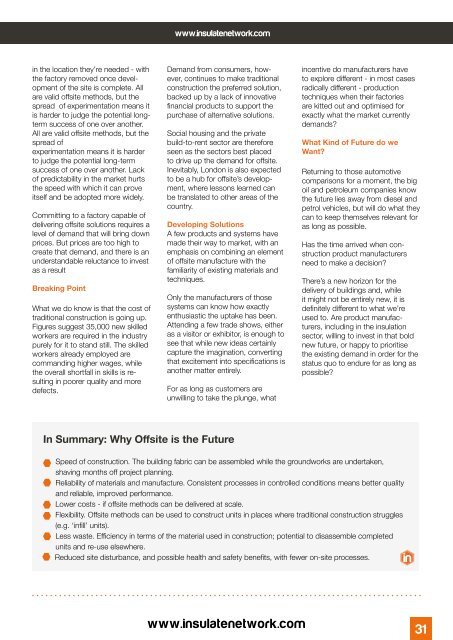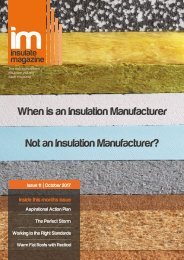Insulate Magazine Ecobuild 2018 Special Edition
Ecobuild 2018 special edition of Insulate Magazine, featuring Insulate exclusive articles and excellent insulation insight from Mauer, BBA, Insulation Superstore, Isover, NIA, Netsezch, 3M, IMA, Quinn, MIMA,
Ecobuild 2018 special edition of Insulate Magazine, featuring Insulate exclusive articles and excellent insulation insight from Mauer, BBA, Insulation Superstore, Isover, NIA, Netsezch, 3M, IMA, Quinn, MIMA,
You also want an ePaper? Increase the reach of your titles
YUMPU automatically turns print PDFs into web optimized ePapers that Google loves.
www.insulatenetwork.com<br />
in the location they’re needed - with<br />
the factory removed once development<br />
of the site is complete. All<br />
are valid offsite methods, but the<br />
spread of experimentation means it<br />
is harder to judge the potential longterm<br />
success of one over another.<br />
All are valid offsite methods, but the<br />
spread of<br />
experimentation means it is harder<br />
to judge the potential long-term<br />
success of one over another. Lack<br />
of predictability in the market hurts<br />
the speed with which it can prove<br />
itself and be adopted more widely.<br />
Committing to a factory capable of<br />
delivering offsite solutions requires a<br />
level of demand that will bring down<br />
prices. But prices are too high to<br />
create that demand, and there is an<br />
understandable reluctance to invest<br />
as a result<br />
Breaking Point<br />
What we do know is that the cost of<br />
traditional construction is going up.<br />
Figures suggest 35,000 new skilled<br />
workers are required in the industry<br />
purely for it to stand still. The skilled<br />
workers already employed are<br />
commanding higher wages, while<br />
the overall shortfall in skills is resulting<br />
in poorer quality and more<br />
defects.<br />
Demand from consumers, however,<br />
continues to make traditional<br />
construction the preferred solution,<br />
backed up by a lack of innovative<br />
financial products to support the<br />
purchase of alternative solutions.<br />
Social housing and the private<br />
build-to-rent sector are therefore<br />
seen as the sectors best placed<br />
to drive up the demand for offsite.<br />
Inevitably, London is also expected<br />
to be a hub for offsite’s development,<br />
where lessons learned can<br />
be translated to other areas of the<br />
country.<br />
Developing Solutions<br />
A few products and systems have<br />
made their way to market, with an<br />
emphasis on combining an element<br />
of offsite manufacture with the<br />
familiarity of existing materials and<br />
techniques.<br />
Only the manufacturers of those<br />
systems can know how exactly<br />
enthusiastic the uptake has been.<br />
Attending a few trade shows, either<br />
as a visitor or exhibitor, is enough to<br />
see that while new ideas certainly<br />
capture the imagination, converting<br />
that excitement into specifications is<br />
another matter entirely.<br />
For as long as customers are<br />
unwilling to take the plunge, what<br />
incentive do manufacturers have<br />
to explore different - in most cases<br />
radically different - production<br />
techniques when their factories<br />
are kitted out and optimised for<br />
exactly what the market currently<br />
demands?<br />
What Kind of Future do we<br />
Want?<br />
Returning to those automotive<br />
comparisons for a moment, the big<br />
oil and petroleum companies know<br />
the future lies away from diesel and<br />
petrol vehicles, but will do what they<br />
can to keep themselves relevant for<br />
as long as possible.<br />
Has the time arrived when construction<br />
product manufacturers<br />
need to make a decision?<br />
There’s a new horizon for the<br />
delivery of buildings and, while<br />
it might not be entirely new, it is<br />
definitely different to what we’re<br />
used to. Are product manufacturers,<br />
including in the insulation<br />
sector, willing to invest in that bold<br />
new future, or happy to prioritise<br />
the existing demand in order for the<br />
status quo to endure for as long as<br />
possible?<br />
In Summary: Why Offsite is the Future<br />
Speed of construction. The building fabric can be assembled while the groundworks are undertaken,<br />
shaving months off project planning.<br />
Reliability of materials and manufacture. Consistent processes in controlled conditions means better quality<br />
and reliable, improved performance.<br />
Lower costs - if offsite methods can be delivered at scale.<br />
Flexibility. Offsite methods can be used to construct units in places where traditional construction struggles<br />
(e.g. ‘infill’ units).<br />
Less waste. Efficiency in terms of the material used in construction; potential to disassemble completed<br />
units and re-use elsewhere.<br />
Reduced site disturbance, and possible health and safety benefits, with fewer on-site processes.<br />
www.insulatenetwork.com<br />
31













